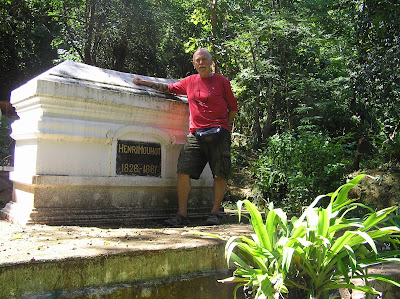I've put a lot of time into writing lesson plans for this University teaching assignment. My little ThinkPad laptop computer has been a fantastic resource for instructional materials, strategies, short stories and so forth.
 |
| Burning the midnight oil, as I search the internet for ideas to keep my Univerisity monk students engaged, excited and enthusiastic about this "Special English Conversation Class." |
Lesson Outline
1. Greet students.
Outline this lesson's objectives and how I'll use of timer for activities. Using the timer keeps equity for all, and when it goes off, the bell notes that students should complete their sentence and focus back on me. Beats my having to call out each time to get students' attention!
 2. Review of last lesson:
My posing questions to students and in the process, checking for understanding, pronunciation, grammer, etc.
3. Grouping for conversation.
Explain that I will use one dice to randomly identify a group by the alphabet letter, and one dice to call either on monk 1, 2, or 3 to respond to questions I ask. Part of CFU process.
2. Review of last lesson:
My posing questions to students and in the process, checking for understanding, pronunciation, grammer, etc.
3. Grouping for conversation.
Explain that I will use one dice to randomly identify a group by the alphabet letter, and one dice to call either on monk 1, 2, or 3 to respond to questions I ask. Part of CFU process.
A. Three monks per group. Monks decide who is number 1, number 2, and number 3.
B. Give each group a letter from the alphabet.
C. Check for understanding for groups and numbers. Group C monk 2.... ask question or Group H monk 3.
4. Bellwork:
Use "Think-Pair-Share"
A. Give a copy of the days bellwork sheet to Monk # 1 in each group.
B. Monk # 1 reads the problem to his group. The others listen and do not speak.
C. Monk # 2 then retells the problem to Monk # 3, followed by Monk # 3 retelling the problem to Monk 2.
 |
| Group E and Monk number 3 will be called on to answer the question. |
D. Use roll of alphabet dice to choose groups to anwer problem. Two to three groups called.
5. Dolch Sight words:
Hand out a copy of list to each student. Total of 220 words, five lists. Will work on one list per class.
A. # 1 reads first list, then #2 reads same list, then #3.
B Ask which words difficult to pronounce. Model if problems and practice with whole class.
6. Difficult words to pronounce
(list identified from Internet from ELL students responding to Facebook, Twitter, etc. asking for list of the most difficult words) Total of 25 words, and sentences. Each sheet has 8 words/phrases.
A. I read the word and phrase. Have students repeat after me.
B. By group: students practice. 1 reads 1; 2 reads 2, etc. Then switch, 1 reads # 2, 2 reads # 3 and 3 reads #1.
C. Model how to write new sentence. CFU
D. By goup: allow think time; have students write new sentences using the difficult words; then by group, read their new sentences.
E. Class: CFU using dice to identify group and student to read their new sentences.
7. Ideoms
(about 8 new ones per class period) Give one copy to each student of handout.
A. I read the sentences. Give the meaning of the word. Students
B. Call on monks to pronounce certain words. Go through whole list.
C. Group: read the phrases to each other.
D. I show how to make a new sentence. Groups make new sentences and read to each other.
8. Three way conversation from a script.
A. I read each sentence. Students just listen.
Ask student if they do not understand any word(s)
Ask students if they want me to read it a second time.
B. Allow students to read / practice in their group.
Change order of students, so monk 3 reads part 1, monk 1 part 3, and monk 3 reads part 2. Allow time to practice.
C. Choose group to come in front and read.
9. Reciprical reading
A. Explain process: monk # 1 reads, monk #2 predicts what may happen next, monk #3 draws a picture to summerize what was just read.
B. Model example : hand out short story as example for students to follow and understand.
C. Group practice: hand out new short story of example
1. Start with paragraph # 1: read, predict; picture
2. Have group members explain to each other.
3. Dice call on group and number to a) summarize, b) predict and c) show the whole class the picture.
Repeat the same exercise for remaiing paragraphs.
10. Review today's lesson
A. Roll dice and call on alphabetical group and monk 1, 2 or 3. Or roll dice for monk 1, 2, or 3 to tell his group the answer.
After all this planning...... what have I got to say........





















































